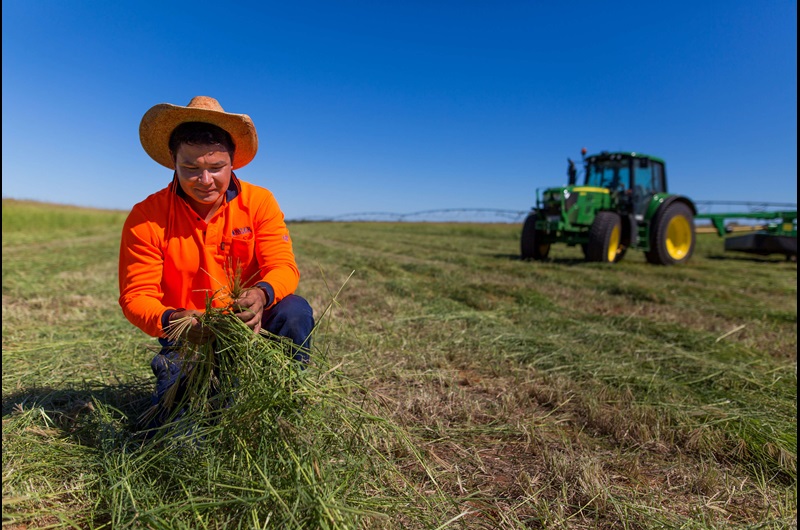Recovering resources
We're always developing new ways to reduce, recover and recycle. What springs to mind when you think of recycling? Cardboard boxes, batteries, tin cans and light bulbs? Chances are, you weren’t thinking about wastewater. But we have! We've been testing the waters on wastewater recycling for years.
Across WA, our treatment plants are recognised as secure, alternative sources of water.
Recycling water
In an environment affected by climate change, making the most of treated wastewater is vital. Over the last 10 years, we have increased the total volume of recycled water by almost 70% across WA. Some regional areas have achieved 100% recycling rate of wastewater through wastewater treatment!
There are many different uses for recycled water:
- Ovals, golf courses and open community areas are thriving from this alternative source.
- The Woodman Point Wastewater Treatment Plant supplies treated wastewater to the Kwinana Water Recycling Plant. Through filtration and reverse osmosis, wastewater is further treated. This quality resource is than used by large scale Kwinana industrial customers.
- Treated wastewater can be utilised for the irrigation of food crops and non-food crops such as canola, turf and trees.
- We support the natural environment by topping up wetlands with recycled water. Or, we directly infiltrate the underlying groundwater which supports the wetland.
- Rhodes Grass hay is grown at our Broome North Wastewater Treatment Plant. This is an environmentally friendly means of disposing of recycled water. Proceeds made from the sale of the hay is being used to run the West Kimberley Community Grants Scheme. Learn more about this partnership.

Harvesting Rhodes Grass
Recharging groundwater
To secure the state’s water supply for the future, we must reduce our dependence on rainfall. That is why we built Australia’s first groundwater replenishment plant.
Groundwater replenishment is where we recharge our groundwater supplies with highly treated wastewater. The water is than stored in our underground aquifers until needed.
Right now, only 4% of Perth’s water supply comes from groundwater replenishment. By 2030, we expect this to increase to 7%.
Learn more about groundwater replenishment

Groundwater replenishment plant
Recovering biosolids
When we treat wastewater, we produce biosolids. Think, big cakes of dirt. These cakes of micro-organisms and solid particles haven’t broken down during treatment. We aim to recover 100% of wastewater sludge from our Perth metropolitan wastewater resource facilities, for treatment and use as biosolids.
We send our biosolids to farmers and gardeners who meet the specific criteria for use. In WA, we can only use biosolids for forestry and on broadacre crops such as wheat and canola. But research continues as new farming practices and quality standards develop.
Biosolids have been used for years to:
- improve crop production
- enrich tree plantations
- reduce landfill
- improve economic returns
- provide topsoil for land used for recreational uses.

Canola fields fertilised by biosolids
Recovering biogas
Wait, you’re talking about fart power? We sure are. When solid matter in wastewater breaks down, it causes a methane or biogas release. Renewable energy is produced through the combustion of biogas. This is used to generate electricity and heat.
We produce renewable energy at our Woodman Point Water Resource Recovery Facility. Where we can, we convert biogas into heat and energy to support our wastewater treatment plant processes. Biogas currently powers around a quarter of the electricity needs of our Woodman Point facility. This reduces our emissions by up to 3,570 tonnes per year.
A soon-to-be-completed renewable energy generator will also help power our Groundwater Replenishment Scheme. The generator uses biogas from our Beenyup Water Resource Recovery Facility. We'll reduce our carbon emissions by up to 7,000 tonnes per year.

Woodman Point Resource Recovery Facility
Avoiding waste
We have aligned with WA’s Waste Strategy. Together we're transforming our state into a sustainable, low waste, circular economy.
We’ve developed an action plan to guide our waste journey. Throughout our operations, we’re always looking for ways to reduce, reuse and recover waste. We also play an important role in educating our customers on sustainable practices. It takes all of us to future proof our water supply and help WA become a circular economy.
Our goals are to:
- avoid generating waste
- recover more valuable resources from waste
- protect the environment by managing waste responsibly.
Research & innovation
To foster innovation, we created a Water Research and Innovation Precinct. Located in Subiaco, the precinct is a collaborative workspace. We use the space to research and pilot test water recovery technologies. Wastewater is 99.97% water. So the potential to develop more recycling options are endless. Exploring these allows us to build a sustainable future and deliver improved efficiencies.